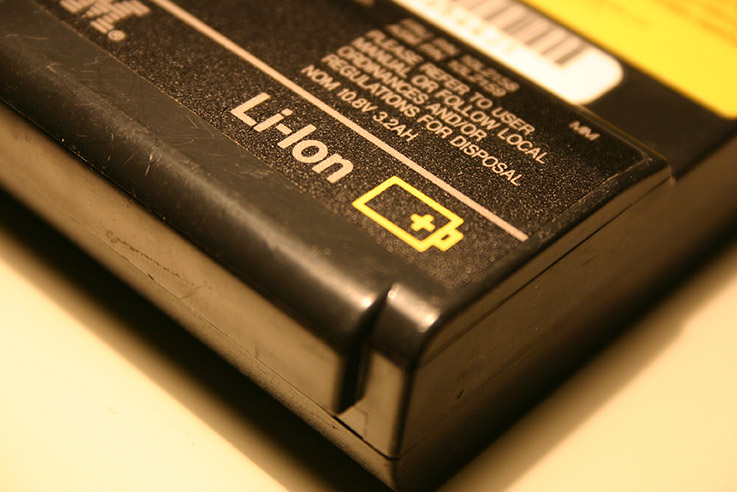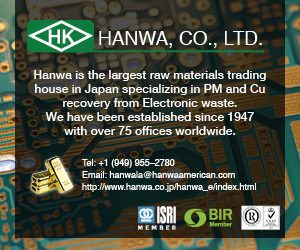
Regulators are looking at lithium-ion battery labeling requirements, but improper collection of the batteries is just one of their recycling challenges. | Allyson Kitts/Shutterstock
California officials are considering regulating lithium-ion battery labels, but an e-scrap processor says they’re missing a bigger issue: Battery-containing electronics are increasingly expensive to process.
Lithium-ion battery fires have caused millions of dollars in damage for residential recycling facilities, and this problem has received wider public attention in the past couple years. In California, the issue led the California Department of Resources Recycling and Recovery (CalRecycle) to explore labeling requirements to ensure the products do not end up in the municipal recycling stream.
Routing battery-containing devices away from the municipal stream and toward the electronics recycling sector would go a long way toward reducing fires at materials recovery facilities (MRFs), CalRecycle explained during a workshop last week.
“We recognize that labeling is a small piece of the puzzle to decreasing fires, increasing battery collection and recycling, and benefiting public health and environment,” said Frederick Thomas, a senior environmental scientist with CalRecycle. “The question is how to make labeling as effective as possible in this regard.”
But during the workshop, e-scrap companies and other recycling stakeholders noted the problem extends beyond just getting batteries to the right type of facility.
“The bigger question is handling these batteries,” said Dennis Kazarian, vice president of Paramount, Calif.-headquartered e-Recycling of California. “These are a growing, growing concern in our industry.”
The cost to disassemble and recycle lithium-ion battery-bearing products is becoming prohibitive, he said, and it’s getting worse. The costs to consumers or collectors delivering lithium-ion battery products to e-scrap firms are beginning to rise, he said. When those costs reach a certain point, it won’t make financial sense for the consumer to properly recycle those products.
“If you don’t start thinking about what it costs us to take apart these batteries, you can forget this rule altogether, because these batteries are going to go right into the street or they’re going to go right into the landfill,” he said.
Ultimately, he said the key issue with lithium-ion batteries is determining who is going to pay for the cost of processing them.
“You can’t be talking about recycling without understanding what the heck is going to happen to it at the end: Where is the end product? What’s going to happen to it? How are you going to handle it? What’s the cost of that? Who’s going to pay for that?” Kazarian said.
The fire hazard extends to e-scrap facilities, as well. Processors last year shared tips on avoiding “thermal events,” meaning fires or explosions caused by lithium-ion batteries that retain residual charge.
CalRecycle staff reassured that the agency understands this concern with the lithium-ion battery stream.
“We realize this is a huge problem, and we’re not saying that [labeling] is going to solve everything,” said Teresa Bui, a CalRecycle special adviser who used to work for environmental advocacy group Californians Against Waste. “This is a very small part of the puzzle.”
Floating EPR as solution
Outside of labeling, recycling stakeholders pushed for stronger management regulations that would also address recycling cost concerns.
“We have had enough experience with other programs to know what works, and I think the solution must be a producer responsibility approach,” said Nick Lapis of Californians Against Waste.
That could be a manufacturer-run program similar to extended producer responsibility (EPR) programs in two dozen states. Or it could be an expansion of California’s existing electronics recycling program, through which consumers pay an upfront fee that CalRecycle handles and remits to e-scrap companies participating in the state program.
A bill considered during the most recent California legislative session proposed an EPR program for lithium-ion batteries and set recycling rate targets for retailers selling products that contain these batteries. That legislation failed to make it to the governor’s desk.
CalRecycle is accepting comments on battery regulations until Dec. 6. Comments can be emailed to [email protected]. Rulemaking could begin early next year if CalRecycle decides to proceed with the project.
Last week’s workshop also drew testimony from the Consumer Technology Association, the Portable Rechargeable Battery Association, garbage and recyclables hauler Waste Management, MRF operator Rethink Waste, and others.
More stories about regulation/oversight
- CA starts OEM requirements for battery-containing devices
- Wisconsin E-Cycle report reflects increasing access
- Illegal e-scrap imports blocked in Malaysia, Thailand



